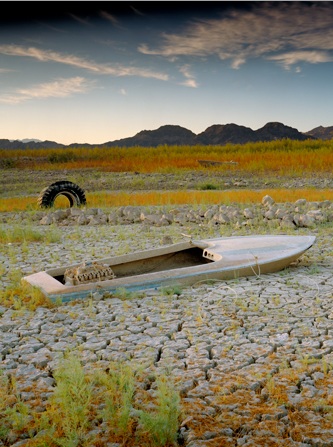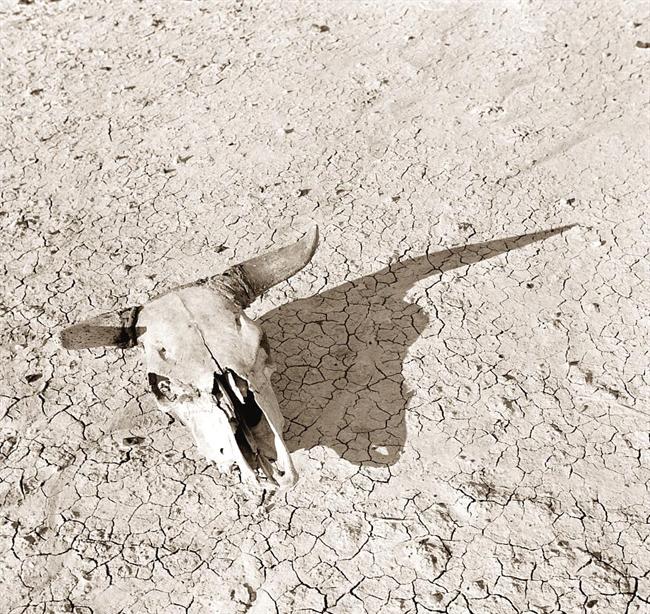The cover of the New York Times Magazine often is the image of uptown style and one place to look for the latest trend. That’s one reason the photograph on this Sunday’s cover was a bit harsh:
You are looking at an abandoned boat near Lake Mead Marina in Nevada. It looks like an odd place to put a marina, doesn’t it? The report, The Perfect Drought, states that Lake Mead has dropped to 49 percent of capacity, a decline consistent with the vanishing snowpack, shrinking rivers, and reduced aquifers throughout the American West. The persistent water loss is an effect of global warming that could have catastrophic consequences. If present trends are not stopped, one can easily imagine a reverse migration from that of the Okies and others who streamed west during the Great Depression of the 1930s.
That migration started with a drought and became known across the world due to John Steinbeck’s The Grapes of Wrath. Equally important was the work of documentary photographers working for the Farm Security Administration. When looking at the Magazine cover, I recalled one of those photographs:
This image from South Dakota was taken by Arthur Rothstein in May 1936. It remains in circulation as one of the classic images of the era. The similarities are obvious: In each we see the cracked ground from which all moisture has evaporated, and only bones remaining where once there had been something vital. There are formal similarities as well: the back-to-front line of the boat and the line across the horns of the skull and its shadow are on the left to right diagonal, and they even start and end at about the same points on each side. Each is a solid structure that also is hollowed out, and the boat’s stripped engine and controls reproduce the machinery of the skull’s eye sockets and sinuses. Although there are tufts of green in the contemporary image, it seems clear in both that as far as large animal life is concerned, we are in a dead zone.
The grass sprouting in the lake bed is not the only difference. Instead of the remnant of an animal, the recent photo shows a dead machine. There is another one in the background, as if in an elephant graveyard. Note two other differences as well: the sublime horizon that is so much a part of the visual understanding of the West, and the rubber tire stuck upright. The wisps of cloud may even hint at rain, but the tire reminds us that it would fall on a society defined by waste, resource depletion, and global warming from excessive use of fossil fuels.
There is one more reason I wanted to compare the two photographs. Rothstein caught hell when it was discovered that the skull photograph was posed: He had dragged it about ten feet to get the contrast between a cracked alkali bed and the shadow of the skull. Republicans pilloried him for deception and tried to make the image into a representative case of New Deal excessiveness. See, the picture’s a fraud, and things can’t be so bad, so why get the government involved?
Of course, It wasn’t deceptive, and the country was deep into a terrible depression compounded in the Great Plains by drought. If you think that the New Deal was not needed, you might as well believe that Rothstein could have ended the Depression by moving the skull back to its original spot. And the same nonsense is going on today: while scientific research and photographic evidence document the rapid acceleration and inevitable peril of global warming, there is a steady stream of chatter on the right about how it’s all alarmism and fraud. If you believe that, I have a marina I’d like to sell you.
Photographs by Simon Norfolk/NB Pictures for the New York Times; Arthur Rothstein/Farm Security Administration. For a scholarly study of Rothstein’s photograph, see Cara A. Finnegan, “The Naturalistic Enthymeme and Visual Argument: Photographic Representation in the ‘Skull Controversy’,” Argumentation and Advocacy 37 (Winter 2001): 133-149.


The only way a global warming computer model works is by pretending that volcanoes do not exist.
If you can find a global warming computer model that uses data from volcanic activity you are doing something nobody else has done.
If you can’t find one and you know volcanoes exist then you know the global warming scaremongers are running a big scam.
[…] Hariman placed an observative post today on A New Deal for Gobal Warming?.Here’s a quick excerpt:Of course, It wasn’t deceptive, and the country was deep into a terrible depression compounded in the Great Plains by drought. If you think that the New Deal was not needed, you might as well believe that Rothstein could have ended the … […]
The situation with Lake Mead is happening all over the world. I don’t want to debate about the causes of global warming, but the effects are phenomenal. Lake Chad in Nigeria, one of the biggest lakes in the world, has almost completely dried up. It is 1/20th of its original size. I have a post about it in my blog.